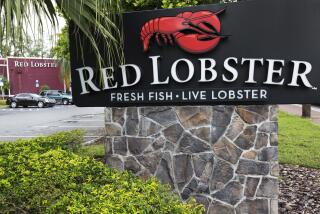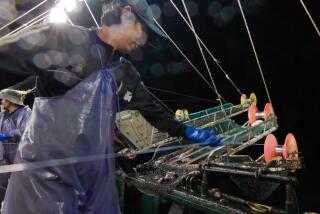Shrimp Market Is Growing Up Fast : As U.S. Sales Leap, Top Supplier Sees Competition Stiffen
- Share via
Attracted by lower prices and low fat content, Americans have found a growing appetite for shrimp, increasing their consumption of the shellfish by 47% during the past five years.
Americans consumed more than 2.2 pounds per capita last year, up from 1.5 pounds in 1982, according to the Commerce Department.
That trend, which contrasts with a decline in U.S. consumption of red meat over the same period, has been a boon to Ocean Garden Products, the San Diego-based U.S. marketing arm of the Mexican shrimp industry.
Ocean Garden, the largest single seller of shrimp in the country, posted 1987 sales of $330 million, roughly double its 1982 figure. Ocean Garden now controls about 11% of the U.S. shrimp market.
But Ocean Garden’s market position is being threatened by producers in countries such as Ecuador, China and Taiwan, which harvest shrimp more cheaply from man-made “shrimp farms” than from the open sea. In fact, Ecuador, where 90% of the shrimp is now produced through aquaculture, surpassed Mexico last year as the world’s leading shrimp exporter to the United States.
As a defensive measure, the Mexican shrimp industry, represented in the United States by Ocean Garden, will spend up to $800 million on aquaculture during the next five years to double its output. Last year, more than 90% of the 86 million pounds of Mexican shrimp exported to the United States through Ocean Garden was caught in the open sea.
Fastest Growing Segment
Ocean Garden President Guido Belsasso said the chief factor in the growth of U.S. shrimp consumption was heightened health consciousness of American consumers. Consumption of all categories of seafood has increased 12% over the past five years as Americans have recognized that it provides fewer calories and fat.
Shrimp and tuna have shown the largest percentage growth in consumption of any types of seafood. As the market for seafood has grown, consumption of all red meats in the United States has dropped--to 137.2 pounds per capita in 1987 from 138.4 pounds in 1982, Agriculture Department spokeswoman Judy Putnam said.
Another important factor in the shrimp market’s expansion has been lower prices. The average wholesale price of popular medium-sized shrimp has declined 25% over the past year to $3.40 per pound, a drop that has made shrimp seem less a delicacy and more a staple to a broader range of consumers.
Although 95% of all shrimp is still consumed in restaurants, the amount purchased at retail outlets is growing steadily, said Alan Bigel, president of New York-based Alba Seafood, a large East Coast distributor.
The main reason for the price drop is the explosion of supply resulting from the advances over the past few years in aquaculture, the method of raising cultivated shrimp in ocean wetlands or ponds. Shrimp aquaculture is a significantly less expensive form of production than fishing on the open sea, said Charles Peckham, president of LMR Fisheries Research, a market research firm and newsletter publisher based in San Diego.
“Aquaculture is nothing new, but it has taken many years for the technology to develop,” Peckham said. Producers “had to learn about water temperature, salinity and nutrition. At each stage, from eggs to adults, the shrimp eat different things and they had to learn what those were.”
Although sea-caught shrimp is generally regarded as tastier and of higher quality than farmed shrimp, the lower costs in aquaculture have made it an increasingly important market factor. As a result, aquaculture now accounts for 15% of worldwide shrimp production, compared to less than 1% a decade ago, Peckham said.
The rapid expansion of shrimp aquaculture in Ecuador helped that country boost its shrimp production in 1987 to 101 million pounds, Peckham said, a whopping 60% one-year increase over that country’s 1986 total. Aquaculture methods have also helped spur China’s growth as an exporter to the United States, with the amount of shrimp it sends to this country reaching 42 million pounds last year, more than double the 1986 figure.
“Aquaculture production is increasing and there is no sign of it abating,” said Jim Gilmore, director of congressional relations for National Fisheries Institute, a Washington-based trade group representing seafood producers. “It’s really taken hold in Asian nations, so I think you will see a very strong import trend continue in shrimp products.”
Belsasso said Mexico’s new shrimp farms, planned mainly for the states of Sonora and Sinaloa, may more than double Mexico’s shrimp exports to the United States to 200 million pounds per year by 1993.
“We’ve pretty much hit the limit with what we can harvest from the sea, so aquaculture is a necessary step,” Belsasso said. He added that Mexico had planned to move into aquaculture in a bigger way before now but its troubled economy and previous financial commitments to the tuna industry precluded such a move.
Ocean Garden Products is generally recognized as a business leader that has helped open up a broader retail market for shrimp through marketing and advertising, Alba Seafood’s Bigel said. He said his shrimp sales are increasing 10% to 15% per year, his fastest growing seafood segment.
Ocean Garden Products is a California corporation that is wholly owned by Productos Pesqueros Mexicanos, a government-owned holding company set up to boost the Mexican fishing industry. PPM buys shrimp from 350 fishing cooperatives operating out of 20 Mexican ports and then exports them to the United States through Ocean Garden Products.
Belsasso said that although his company also sells lobster, abalone and fin fish, shrimp account for 85% of its revenue. The company’s main warehouse facilities are located across the border from Nogales, Ariz., and Brownsville, Tex., the two main ports of entry for its shrimp.
As part of an effort to raise capital, the Mexican government recently announced plans to sell various assets of PPM, including several shrimp processing plants. But Belsasso said Ocean Garden Products will not be among the assets sold.
Belsasso is a medical doctor by training, who at one time was a practicing psychiatrist in Mexico and who also holds a master’s degree in business administration. He held several Mexican government posts, including founding director of a World Health Organization drug abuse prevention center in Mexico City.
More to Read
Inside the business of entertainment
The Wide Shot brings you news, analysis and insights on everything from streaming wars to production — and what it all means for the future.
You may occasionally receive promotional content from the Los Angeles Times.










